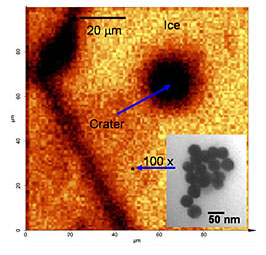ATHENS, Ohio, March 31, 2006 -- Nanoparticles of gold can act as tiny, precise and powerful heaters, which potentially could be used in biomedical applications, according to a new study at Ohio University.
When stimulated with the right frequency of laser light, a small collection of metal nanoparticles, such as gold, can heat an area up to 1000 times its size, according to OU scientists Hugh Richardson and Sasha Govorov.

A cluster of gold nanoparticles 50 nanometers in diameter created a much larger crater in the ice sample, shown here. The cluster is represented in this image by a small black dot that is actually 100 times the actual size of the nanoparticles. (Photo courtesy of Hugh Richardson)
The heating properties were observed in ice, water and a polymer shell that was designed to mimic material in biological systems. Though the ice did not melt when heated by low-intensity laser alone, it dissolved once a gold nanoparticle was embedded, said the scientists. The gold particle is 50 nanometers in size, which is 200,000 times smaller than an object 1 centimeter in size, Govorov said.
The process not only generates a considerable amount of heat at much larger scale than the nanoparticle, but also is very precise, the researchers said. By using biolinkers, the nanoparticles can be designed to affect specific targets. Biolinkers are special, sticky molecules that are created to link with only certain types of cells. In a biomedical application, a few gold nanoparticles could be used to generate heat to impact a single macroscale (visible with the naked eye) object, such as a tumor cell.
"What's amazing is that we're taking particles that you can't even image with a light microscope, and all of the sudden they cause a huge change in a macroscopic system," said Richardson, whose project was funded by Ohio University's NanoBioTechnology Initiative, one of three major research priorities of the institution.
The scientists will collaborate with other researchers to continue to test and design efficient nanoscale heaters in more complicated systems, such as in the cells from living organisms, Govorov said.
Richardson is a professor of chemistry and Govorov is an associate professor of theoretical physics at Ohio University. Other collaborators in the project include Zachary Hickman, Alyssa Thomas, Wei Zhang and Martin Kordesch, all of Ohio University. The findings have been published online by the journal Nano Letters.
For more information, visit: http://news.research.ohiou.edu